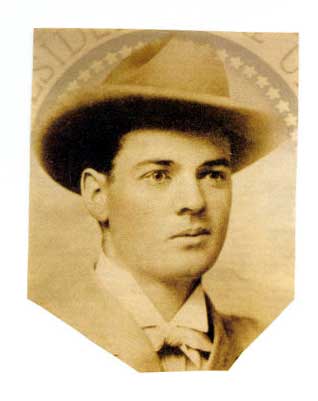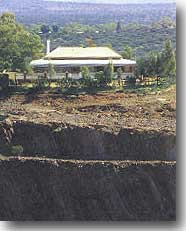|
Which future American President worked as a 23 year old Mining Engineer in Australia? It was Herbert Hoover!
The population at Leonora is but 1,000, but this houseis a local landmark, and it was here, the future President ( 1929 -1932 ) spent the years 1897 through 1898. Ironically it was gold that made Hoover's reputation in this remote area of Western Australia, and he became feted as a mining expert both at home and abroad. As President, he was oft times blamed as responsible for the Great Depression in the US during the 1930's, as many as 12 million were unemployed and 18 million relied on relief money for their survival. Britain had abandoned the gold standard at that time, but Hoover declined to follow them down that road. He was advised to devalue the US $ by printing paper money not backed up by gold, but refused. In 1932, the Democrat, Franklin D. Roosevelt ensured Hoover left the White House as he was installed as President, and immediately took the US off the Gold Standard. Hoover was born in 1874 in the American west, his parents dying whilst he was young, and relatives brought him up. In May of 1895, he graduated from Stanford University in both Geology and Engineering. He had some brief experience at 22, labouring in mines in Colorado and Nebraska, but his Quaker upbringing did not preclude him lying about his age. In London, the Bewick Moreing Company were advertising for a mining inspector to oversee its Western Australian gold mines, and he should be at least 35 years of age. Hoover said he was 36, he boarded a ship for London, growing a beard enroute to disguise his relative youth. Hoover won the job and was soon on his way by ship to Australia, arriving in 1897, at the gold town of Coolgardie, Western Australia. His arrival coincided with the last big gold rush of the 19th. Century, in one year alone, some 800 gold mines in WA came to be listed on the London Stock Exchange. The job given to Hoover was to pick the mines with prospects, thus he toured the gold fields striking out all the potential Dud ones. To quote Hoover "Good engineers are called in as physicians to mend the lame ducks. This we do by killing the bad ones immediately, at least that is what I do." At Leonora he came across a fledgling mine The Sons of Gwalia, and predicted it as a mine of depth with a golden future, and Hoover urged his company to acquire it, and put him in as its manager. He hated the "Red dust, black flies and white heat" he also did not like the camels he was forced to use prior to the advent of the motor car. In writing to a friend in the US, he said "Its a hell of a country, but the chances of getting on are exceptional, especially with the inside position I now hold." Not impressed by the easy going and independent Australian workers, he tended to employ both Italian and Austrian labourers. Hoover was forging for himself an unenviable reputation, the London Financial Times called him: "One of the ablest mining engineers in Australia."
Herbert Hoover on the camel, ready to lead a prospecting party in Western Australia, 1898.
In 1898 Hoover ordered a manager's house to be built at Leonora, but by the time of its completion, he had moved on. His company promoted the young mining engineer, and moved him off to China, where they had concessions to open up coal mines. Hoover was now made, his contract gave him 1/5th. of all the China profits, and a great salary, in 1901, the San Francisco Chronicle named him as the: "Highest salaried man of his age in the world." At that stage he was earning $US 33,000, which would translate today to some $US 680,000, mining shares he gathered had a value of $US 250,000 ( today about $US 5 million ). Prior to Hoover's departure from Western Australia in 1898, he dashed off a four word telegram to his sweetheart in the US, and a fellow graduate from Stanford University, Lou Henry: "Will you marry me?" A single word response came back: "Yes." They married in the United States, and left for China the very next day, on arrival there they ran straight in to the Boxer Rebellion. With his wife Lou, Hoover returned to Australia in 1902, now a Director of Bewick Moreing, and Manager of their West Australian operations. He became a founder of Zinc Corporation, later it became Rio Tint Zinc of Broken Hill. Several further visits were made to Australia, the last one in 1907, when the Hoovers at last stayed in the home he had planned at Leonora. Hoover covered Australia and the operations of 32 mines which employed 9,000 men, turning in profits grossing millions of dollars. His mining career had finished by the time he turned 35, a wealthy and respected man. As Director of an American Relief Committee, Hoover assisted 120,000 Americnas to go home during WW1. Hoover filled a number of Governmental roles, including Secretary of Commerce, finally taking the White House as a Republican President in 1929. The Sons of Gwalia mine became one of the 10 richest in Australian history, it produced gold right up to 1963, having yielded 2.6 million ounces of gold from its shafts up to 1,000 meters below the surface. Charles Moreing, Hoover's boss said: "It was the mine out of which we made the most profit of any business we did." Notwithstanding Hoover's success, his legacy in Western Australia is minimal, no streets, no towns named after him, only at the pit entrance to the Sons of Gwalia is his name given a mention, this mine closed in 1963, just a year before Hoover died, and the house at Leonora fell into disrepair. In 1983, two WA mining lawyers, Peter and Chris Lalor rescued the home and its gardens, when they bought the Sons of Gwalia, open pit mining went on until 1999, when finally the pit was exhausted, and operations once more went underground. Conclusion.
Hoover's House restored at Leonora as it looks today.
|



